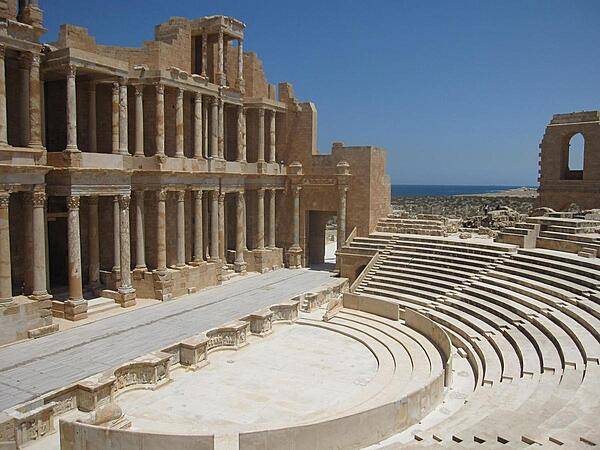
conventional long form: State of Libya
conventional short form: Libya
local long form: Dawlat Libiya
local short form: Libiya
etymology: name derives from the Libu, an ancient Libyan tribe first mentioned in texts from the 13th century B.C.
in transition
name: Tripoli (Tarabulus)
geographic coordinates: 32 53 N, 13 10 E
time difference: UTC+2 (7 hours ahead of Washington, DC, during Standard Time)
etymology: originally founded by the Phoenicians as Oea in the 7th century B.C., the city changed rulers many times over the successive centuries; by the beginning of the 3rd century A.D. the region around the city was referred to as Regio Tripolitana by the Romans, meaning "region of the three cities" - namely Oea (i.e., modern Tripoli), Sabratha (to the west), and Leptis Magna (to the east); over time, the shortened name of "Tripoli" came to refer to just Oea, which derives from the Greek words tria and polis meaning "three cities"
22 governorates (muhafazah, singular - muhafazat); Al Butnan, Al Jabal al Akhdar, Al Jabal al Gharbi, Al Jafarah, Al Jufrah, Al Kufrah, Al Marj, Al Marqab, Al Wahat, An Nuqat al Khams, Az Zawiyah, Banghazi (Benghazi), Darnah, Ghat, Misratah, Murzuq, Nalut, Sabha, Surt, Tarabulus (Tripoli), Wadi al Hayat, Wadi ash Shati
24 December 1951 (from UN trusteeship)
Liberation Day, 23 October (2011)
history: previous 1951, 1977; in July 2017, the Constitutional Assembly completed and approved a draft of a new permanent constitution; in September 2018, the House of Representatives passed a constitutional referendum law in a session with contested reports of the quorum needed to pass the vote and submitted it to the High National Elections Commission in December to begin preparations for a constitutional referendum
Libya's post-revolution legal system is in flux and driven by state and non-state entities
has not submitted an ICJ jurisdiction declaration; non-party state to the ICCt
citizenship by birth: no
citizenship by descent only: at least one parent or grandparent must be a citizen of Libya
dual citizenship recognized: no
residency requirement for naturalization: varies from 3 to 5 years
18 years of age, universal
chief of state: President, Presidential Council, Mohammed Al MENFI (since 5 February 2021)
head of government: GNU Interim Prime Minister Abdul Hamid DUBAYBAH (since 5 February 2021)
elections/appointments:
Libya’s first direct presidential election, scheduled for 24 December 2021, was not held; no new date has been set for elections
description: unicameral House of Representatives (Majlis Al Nuwab) or HoR (200 seats including 32 reserved for women; members directly elected by majority vote; member term NA); note - the High State Council serves as an advisory group for the HoR
elections: last held on 25 June 2014
election results: percent of vote by party - NA; seats by party - NA; composition; note - only 188 of the 200 seats were filled in the June 2014 election because of boycotts and lack of security at some polling stations; some elected members of the HoR also boycotted the election
highest court(s): Libya's judicial system consists of a supreme court, central high courts (in Tripoli, Benghazi, and Sabha), and a series of lower courts; the judicial system is factious given the ongoing tension between Libya's eastern and western regions; since 2011, Libyan political factions and armed groups have targeted judges and courthouses
NA
ABEDA, AfDB, AFESD, AMF, AMU, AU, BDEAC, CAEU, COMESA, FAO, G-77, IAEA, IBRD, ICAO, ICC (NGOs), ICRM, IDA, IDB, IFAD, IFC, IFRCS, ILO, IMF, IMO, IMSO, Interpol, IOC, IOM, IPU, ISO, ITSO, ITU, LAS, LCBC, MIGA, NAM, OAPEC, OIC, OPCW, OPEC, PCA, UN, UNCTAD, UNESCO, UNHRC, UNIDO, UNSMIL, UNWTO, UPU, WCO, WFTU (NGOs), WHO, WIPO, WMO, WTO (observer)
chief of mission: Ambassador (vacant); Chargé d'Affaires Fadil S M OMAR (since 17 July 2023)
chancery: 1460 Dahlia Street NW, Washington, DC 20012
telephone: [1] (202) 944-9601
FAX: [1] (202) 944-9606
email address and website:
info@embassyoflibyadc.com
https://www.embassyoflibyadc.org/
chief of mission: Ambassador (vacant); Chargé d'Affaires Jeremy BERNDT (since 14 October 2023)
embassy: US Embassy Tripoli operations suspended in 2014
mailing address: 8850 Tripoli Place, Washington, DC 20521-8850
telephone: [216] 71-107-000
email address and website:
Webmaster_Libya@state.gov
https://ly.usembassy.gov/
note: the US Embassy in Tripoli closed in July 2014 due to Libyan civil unrest; embassy staff and operations currently are located at US Embassy Tunis, Tunisia
three horizontal bands of red (top), black (double width), and green with a white crescent and star centered on the black stripe; the National Transitional Council reintroduced this flag design of the former Kingdom of Libya (1951-1969) on 27 February 2011; it replaced the former all-green banner promulgated by the QADHAFI regime in 1977; the colors represent the three major regions of the country: red stands for Fezzan, black symbolizes Cyrenaica, and green denotes Tripolitania; the crescent and star represent Islam, the main religion of the country
star and crescent, hawk; national colors: red, black, green
name: "Libya, Libya, Libya"
lyrics/music: Al Bashir AL AREBI/Mohamad Abdel WAHAB
note: also known as "Ya Beladi" or "Oh, My Country!"; adopted 1951; readopted 2011 with some modification to the lyrics; during the QADHAFI years between 1969 and 2011, the anthem was "Allahu Akbar," (God is Great) a marching song of the Egyptian Army in the 1956 Suez War
total World Heritage Sites: 5 (all cultural)
selected World Heritage Site locales: Archaeological Site of Cyrene;  ,
,  ; Rock-Art Sites of Tadrart Acacus;
; Rock-Art Sites of Tadrart Acacus; 
NOTE: The information regarding Libya on this page is re-published from the 2024 World Fact Book of the United States Central Intelligence Agency and other sources. No claims are made regarding the accuracy of Libya 2024 information contained here. All suggestions for corrections of any errors about Libya 2024 should be addressed to the CIA or the source cited on each page.
This page was last modified 04 May 24, Copyright © 2024 ITA all rights reserved.